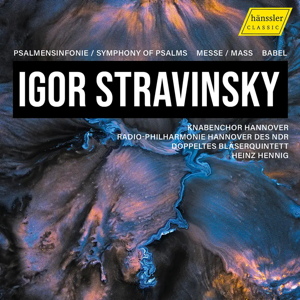
Igor Stravinsky (1882-1971)
Symphony of Psalms (1930)
Mass (1948)
Babel (1944) English and German version
Knabenchor Hannover, Doppeltes Bläserquintett, Radio-Philharmonie Hannover des NDR/Heinz Hennig
rec. 1991-93, Large Broadcasting Hall of the Hanover Radio House, Hanover, Germany
Hänssler Classic HC24022 [50]
These recordings of Stravinsky sacred music come from the early 1990s, and are unusual in having the top two lines of the chorus, in the Symphony of Psalms and the Mass, sung by boys. Stravinsky wanted this; in the prefatory material to the score, he states that ‘the choir should contain children’s voices’, though he goes on to say that they may be replaced by female voices if a children’s choir isn’t available. It isn’t explained in the booklet notes for this CD, however, where the tenor and bass voices come from – not the Knabenchor (Boys’ Choir) presumably. In fact, while we’re about it, I should say that the booklet is the weakest part of this issue; not only is it vague about the choral forces, the English translation is remarkably poor.
Aside from that carp, this is a creditable recording. The choir is well trained and confident, the instrumentalists alert and stylish. It features Stravinsky’s two best-known sacred works, alongside a curiosity, the little cantata Babel – though why Hänssler decided to include it twice, once in English (the original) and once in German is a matter for slightly puzzled conjecture!
Babel, whose text is taken from the book of Genesis,is scored for narrator, male chorus and orchestra, the men entering to voice the words of God. The work was commissioned in the USA as part of a project called Genesis Suite, to which a number of composers contributed, including Arnold Schönberg, who wrote the purely instrumental Prologue. It is well documented that he and Stravinsky had no time for each other at all; so it’s interesting that the following year, Schönberg wrote an independent piece for precisely the same forces Stravinsky had employed in Babel – narrator, men’s voices, orchestra – and called it A survivor from Warsaw, one of his most celebrated works.
Working backwards through the tracks, we come to the Mass, which occupied Stravinsky off and on between 1944 and 1948, and was first performed complete in the latter year. It was one of the very small number of works that he wrote without a commission of some sort, which may explain the very ascetic character of the music. I feel that the choir in this recording is too large – a chamber choir gives more clarity and also a better balance with the instrumental ensemble of 2 oboes, cor anglais, 2 bassoons, 2 trumpets and three trombones.
And then there’s the Symphony of Psalms, certainly one of Stravinsky’s most striking and characteristic works. It offers a strange entente between on the one hand the Latin text of the psalms, and on the other the rhythmic incantations of the Russian Orthodox tradition. Although the discipline and grasp of the work of conductor and performers is admirable, the sound has an unmistakably ‘studio’ feel to it, and a sense of space is thus lacking. This may sound like a small criticism; but the need for the sound to ‘bloom’ as in a cathedral or large church is an essential part of the work’s character.
In other places, Hennig’s reading comes over as too perfunctory, and lacking in passion and propulsion; for example, towards the end of the first movement, where the momentum leading to the climaxes just isn’t there. And the crucial final section of the third movement, with its gently rocking motion in the choral lines, is just too fast for its beauty to fully register – as it does, for example, in Stravinsky’s own stunning recording of 1963.
That recording uses of course an adult choir – the Toronto Festival Singers – so if you are really looking for the freshness of tone found with boys’ voices, my recommendation would be for James O’Donnell’s excellent Hyperion version with the Westminster Cathedral Choir, which also benefits from having been recorded in a large building – not Westminster Cathedral, but the church of St. Jude-on-the-Hill, Hampstead. I have to admit, though, that when I want to hear this wonderful work, I am always drawn back to Stravinsky’s own reading of 1963 mentioned above. The thing is, Stravinsky ignores many of his own markings, of tempos, articulation, dynamics or whatever; the message he was sending out encouraged musicians to do it their own way, but with conviction and truth to the work’s essential character.
Gwyn Parry-Jones
Previous review by Néstor Castiglione (May 2024)
Buying this recording via the link below generates revenue for MWI, which helps the site remain free.

















